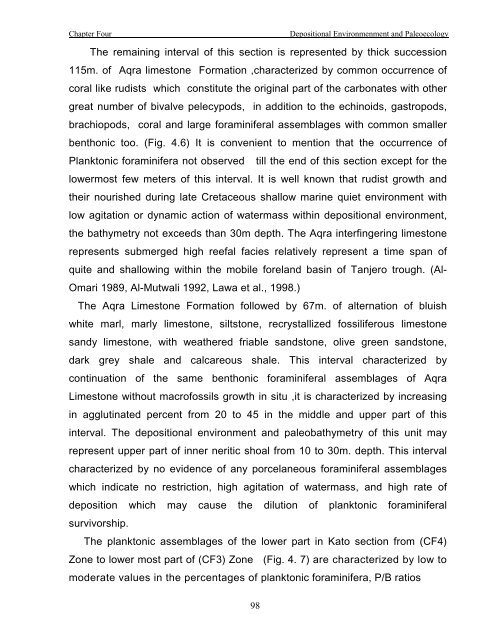biostratigraphy and paleoecology of cretaceous/tertiary boundary in ...
biostratigraphy and paleoecology of cretaceous/tertiary boundary in ...
biostratigraphy and paleoecology of cretaceous/tertiary boundary in ...
You also want an ePaper? Increase the reach of your titles
YUMPU automatically turns print PDFs into web optimized ePapers that Google loves.
Chapter Four<br />
Depositional Environmenment <strong>and</strong> Paleoecology<br />
The rema<strong>in</strong><strong>in</strong>g <strong>in</strong>terval <strong>of</strong> this section is represented by thick succession<br />
115m. <strong>of</strong> Aqra limestone Formation ,characterized by common occurrence <strong>of</strong><br />
coral like rudists which constitute the orig<strong>in</strong>al part <strong>of</strong> the carbonates with other<br />
great number <strong>of</strong> bivalve pelecypods, <strong>in</strong> addition to the ech<strong>in</strong>oids, gastropods,<br />
brachiopods, coral <strong>and</strong> large foram<strong>in</strong>iferal assemblages with common smaller<br />
benthonic too. (Fig. 4.6) It is convenient to mention that the occurrence <strong>of</strong><br />
Planktonic foram<strong>in</strong>ifera not observed till the end <strong>of</strong> this section except for the<br />
lowermost few meters <strong>of</strong> this <strong>in</strong>terval. It is well known that rudist growth <strong>and</strong><br />
their nourished dur<strong>in</strong>g late Cretaceous shallow mar<strong>in</strong>e quiet environment with<br />
low agitation or dynamic action <strong>of</strong> watermass with<strong>in</strong> depositional environment,<br />
the bathymetry not exceeds than 30m depth. The Aqra <strong>in</strong>terf<strong>in</strong>ger<strong>in</strong>g limestone<br />
represents submerged high reefal facies relatively represent a time span <strong>of</strong><br />
quite <strong>and</strong> shallow<strong>in</strong>g with<strong>in</strong> the mobile forel<strong>and</strong> bas<strong>in</strong> <strong>of</strong> Tanjero trough. (Al-<br />
Omari 1989, Al-Mutwali 1992, Lawa et al., 1998.)<br />
The Aqra Limestone Formation followed by 67m. <strong>of</strong> alternation <strong>of</strong> bluish<br />
white marl, marly limestone, siltstone, recrystallized fossiliferous limestone<br />
s<strong>and</strong>y limestone, with weathered friable s<strong>and</strong>stone, olive green s<strong>and</strong>stone,<br />
dark grey shale <strong>and</strong> calcareous shale. This <strong>in</strong>terval characterized by<br />
cont<strong>in</strong>uation <strong>of</strong> the same benthonic foram<strong>in</strong>iferal assemblages <strong>of</strong> Aqra<br />
Limestone without macr<strong>of</strong>ossils growth <strong>in</strong> situ ,it is characterized by <strong>in</strong>creas<strong>in</strong>g<br />
<strong>in</strong> agglut<strong>in</strong>ated percent from 20 to 45 <strong>in</strong> the middle <strong>and</strong> upper part <strong>of</strong> this<br />
<strong>in</strong>terval. The depositional environment <strong>and</strong> paleobathymetry <strong>of</strong> this unit may<br />
represent upper part <strong>of</strong> <strong>in</strong>ner neritic shoal from 10 to 30m. depth. This <strong>in</strong>terval<br />
characterized by no evidence <strong>of</strong> any porcelaneous foram<strong>in</strong>iferal assemblages<br />
which <strong>in</strong>dicate no restriction, high agitation <strong>of</strong> watermass, <strong>and</strong> high rate <strong>of</strong><br />
deposition which may cause the dilution <strong>of</strong> planktonic foram<strong>in</strong>iferal<br />
survivorship.<br />
The planktonic assemblages <strong>of</strong> the lower part <strong>in</strong> Kato section from (CF4)<br />
Zone to lower most part <strong>of</strong> (CF3) Zone (Fig. 4. 7) are characterized by low to<br />
moderate values <strong>in</strong> the percentages <strong>of</strong> planktonic foram<strong>in</strong>ifera, P/B ratios<br />
98

















